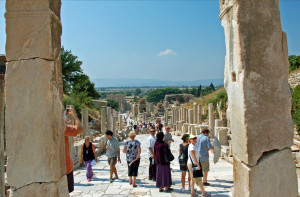Ephesus was one of the Roman Empire’s most important and sophisticated cities, with a population of up to 500,000 and a beautiful library housing more than 12,000 scrolls. Completely abandoned in the fifteenth century, the city near modern Izmir has since been revived by meticulous restorations of its most extraordinary façades and is now among Turkey’s most important tourist destinations. Many visitors seek the sites of historical religious controversies and controversial religious histories.
First century Ephesians worshipped the fertility goddess Artemis, whose temple was one of the seven wonders of the ancient world. According to the Book of Acts, when the Apostle Paul taught Ephesians that their silver idols of Artemis were not real gods, silversmiths touched off a riot in the 25,000-seat Great Theater, then the largest in the world. The Great Theater is still largely intact, but the famous temple to Artemis was demolished by a Christian mob in 401 after Emperor Theodosius I outlawed paganism. Only enough rubble has been recovered to recreate a single column.
Early Christians believed that John, the beloved disciple of Jesus, lived and was buried near Ephesus, so Emperor Justinian built a magnificent basilica over the claimed grave site in the sixth century. Jesus’ mother Mary also lived in Ephesus, or so the story goes, because Jesus tasked John with looking after her just before he died on the cross. Visitors to Ephesus climb a steep hill to a brick house where a German seer said Mary lived, many wondering why the house looks so recently built. Reflecting the importance of both Jesus and Mary to Muslims, the fourteenth century Isa (“Jesus”) Bey Mosque was built within sight of the basilica of St. John.
In its prime, Ephesus rivaled Rome, Antioch, Alexandria and Constantinople in prestige among Christian cities and was the location of three church councils. The most important, held in 431, declared that Mary was properly called the “Mother of God,” causing the followers of Nestorius, who rejected this conclusion, to start their own branch of Christianity.
In about 450, an influential bishop reported that seven young Christian men had fallen asleep in a cave near Ephesus while avoiding Roman persecution and awoke about two hundred years later, amazed that the Empire was now Christian. The Quran reports essentially the same story, the most significant difference being that a dog stayed awake to guard the cave. A grotto near Ephesus honors the “Seven Sleepers of Ephesus.”
Which of the religious claims for Ephesus are real is largely a matter of belief. But what is undoubtedly real is the powerful experience of visiting a city that has inspired so many beliefs.

Comments are closed.